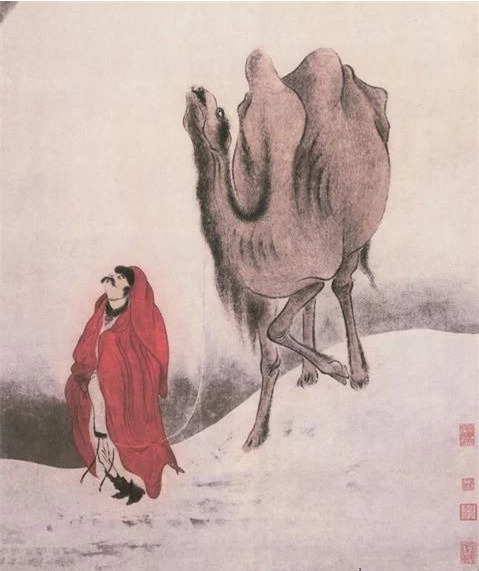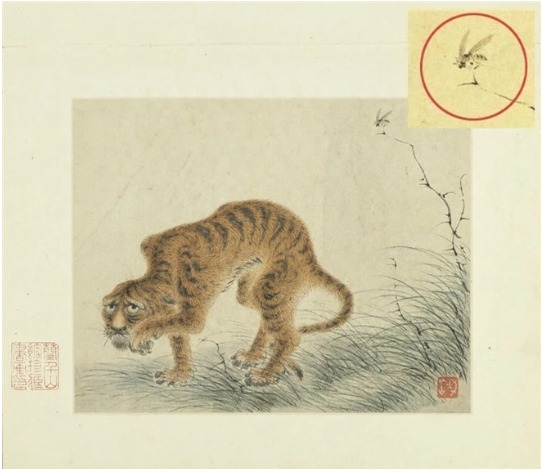A STRANGE MOUNTAIN TIGER
Far from the majestic image of a tiger in Chinese culture, the tiger in this painting has a fearful gait and eyes. Why is that?
The National Palace Museum is one of the museums with the most royal artifacts and works of art in the world. It displays more than 697,000 pieces of Chinese history from the Neolithic period to the end of the Qing Dynasty.
One of the works that has received special attention in the museum is the 300-year-old painting titled “Mountain tiger”. According to Sina news site, the painting “Mountain tiger” is only displayed once every few years, the rest of the time, the painting will be carefully kept in the museum’s storage room.

Detail of the work Mountain tiger
The painting has caused fierce controversy because it depicts a tiger with an appearance that is completely different from the concept of Chinese culture.
Tiger is the embodiment of strength and courage, the animal is also worshiped in temples with a position comparable to dragon, however, the tiger in the painting has its ears folded, its body arched, and its feet walking very cautiously. Especially its fearful eyes looking sideways. This is clearly not the posture of a majestic “king of mountain and jungle” but exactly like a sick cat. What is making the tiger so afraid? To answer this question, we must start with the author of the painting – the famous painter Hua Yan.

Mountain tiger of artist Hua Yan
TALENTED BUT UNLUCKY
Hua Yan (1682-1756) was a typical representative of the Yangzhou school of painting during the Qing Dynasty. The fate of this painter was difficult. Since childhood, he loved painting, poetry and calligraphy, but his family unfortunately fell into poverty and had no money for him to continue studying and buy paper and ink for painting.
However, Hua Yan did not give up his dream. He painted on the ground and tried hard to improve his skills every day. Because he was close to nature since childhood, Hua Yan’s paintings of landscapes, plants and animals were very outstanding. He had a sharp eye and the ability to perceive beauty.
His paintings often depicted the grace of nature through the colors of flowers and leaves or the smooth fur of animals, so many painters at that time admired him.
Despite his talent, Hua Yan had a quiet personality, did not like to socialize and was somewhat arrogant, so his painting career did not flourish throughout his life. He could only sell paintings to calligraphy and antique painting shops at a low price, living in poverty all his life.
The painting theory book “Tập khổ trai họa nhứ” recorded that once, painter Hua Yan was introduced to sell paintings in Beijing.
When he entered a calligraphy shop in the capital, he found a painting that was very similar to his work, but it turned out to be a painting with someone else’s signature.
What made Hua Yan even angrier was that the price of the painting was many times higher than his real painting. Hua Yan left the capital and never returned.
The Yangzhou school of painting that he pursued was also to express the feelings of intellectuals who worked hard to make a living by selling paintings but were not treated fairly in society.
MEANING OF THE PAINTING
The painting “Mountain tiger” was painted by Hua Yan when he was 70 years old. Many experts speculate that the tiger in his painting is reminiscent of the camel in the painting “Snow on Tianshan mountain” painted by Hua Yan in his middle age.
The painting depicts a man in a red shirt leisurely leading a camel through the snow-capped Tianshan mountain. The color of the man’s outfit stands out against the pure white background of the snowy mountain.

The work Snow in Tianshan of artist Hua Yan
This is a work that has received countless compliments, and was also adapted from a time when he personally traveled through Tianshan Mountain. The painting of a tiger in the stance of the camel in “Mountain tiger” may be Hua Yan’s way of looking back at the arrogant years of his life.
However, after carefully examining every detail in the painting, modern art experts have realized something more special. It turns out that there are a few small black spots in the upper right corner of the painting, when magnified 10 times, they realized it was a bee.

Detail of the bee
The tiger in the painting appears sad and worried because it is afraid of being stung by the bee. Its eyes are also directed at the exact position of the insect that is threatening it.
According to experts, the image of the tiger is the way the artist Hua Yan depicts his own identity. He is a talented person but is bothered by “bees and butterflies” so that the gentleman cannot stand up straight all his life.
The painting “Mountain tiger” not only has a deep satire but also sheds light on the sorrow for the fate of talented people lost in the current situation.
Understanding this message, we can see the beauty in the way Hua Yan titled “Mountain tiger”. The artist did not use the word “mountain” (山) but used the word “feng” (峰), which means mountain peak or hump. This word describes the tiger’s hunched back and bowed head, and also alludes to the portrait of a gentleman with many ambitions but having to bow his head in society. In addition, the word “feng” (峰) in Chinese is homophonous with the word “bee” (蜂).

A work of Hua Yan

Portrait of Hua Yan (1682-1756)
Source: Tạp chí Doanh nghiệp Việt Nam







